WORDPRESS
9 Best Astra Theme Alternatives for Faster Loading (2024)

Finding the perfect theme for your WordPress website is crucial.
While Astra has long been a favorite among users, it has some limitations. Hence, you must explore alternatives that best fit your needs.
Based on my extensive experience over the past years, Kadence WP is the best WordPress theme. I’ve been with Kadence for the past three years, and it is for all my sites due to its smooth WP blocks, superior performance, ease of use, and advanced customization features.
Its lightweight structure ensures fast load times, while its robust design tools offer unparalleled flexibility, making it an ideal choice for many website projects.
I discuss the top Astra theme alternatives in this article, each offering unique strengths and capabilities.
Join me as I explore Kadence WP and other notable themes, such as GeneratePress, OceanWP, and Elementor Hello, to help you make an informed decision about your next website build.
9 Best Astra Theme Alternatives
1. Kadence WP Theme (Overall Best Alternative)
If you are looking for an Astra Theme alternative that offers a great user experience, Kadence WP Theme is an excellent choice. It is a multipurpose WordPress theme that is perfect for creating any website.
Kadence WP Theme is known for its flexibility, customization options, and user-friendly interface.
Kadence WP Theme Key Features
- Lightweight and Fast: The Kadence WP Theme is lightweight and loads quickly, making it perfect for creating fast-loading websites.
- Page Builder Compatibility: Kadence WP Theme is compatible with popular page builders like Elementor, Beaver Builder, and Gutenberg.
- Customizable Header and Footer: Kadence WP Theme allows you to easily customize your website’s header and footer.
- Advanced Typography: Kadence WP Theme offers advanced typography options, allowing you to choose from over 800 Google fonts.
- WooCommerce Integration: Kadence WP Theme integrates seamlessly with WooCommerce, making it perfect for creating online stores.
- Starter Templates: Kadence WP Theme comes with various starter templates that you can use to create your website quickly.
Kadence WP Theme Pros and Cons
Here are the pros and cons of using the Kadence WP Theme:
Pros:
- Lightweight and fast-loading.
- Easy to use and customize.
- Compatible with popular page builders.
- Offers advanced typography options.
- Comes with a variety of starter templates.
- Integrates seamlessly with WooCommerce.
Cons:
- The free version of the Kadence WP Theme has limited features.
- The pricing plans are a bit expensive compared to other themes.
Kadence WP Theme Pricing
- Free Plan: This plan is free and excellent for website creators wanting to start.
- Essentials Plan: This plan costs $149/year and gives you all the essentials, like the pro versions of the Kadence theme and starter templates.
- Full Plan: This plan costs $219/year and gives you full access to all the tools to help you sell.
- Lifetime Plan: With this plan, you get every product in its complete bundle, lifetime support, updates, and all future products for a one-time payment of $799/lifetime.
2. GeneratePress
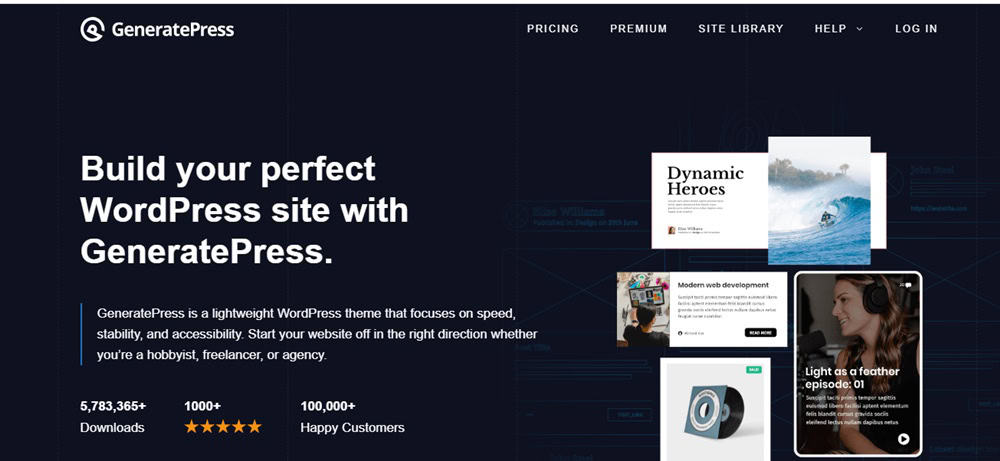
If you’re looking for a lightweight and flexible WordPress theme that can be easily customized, GeneratePress is an excellent alternative to Astra. It is a popular theme among developers and users known for its speed, security, and ease of use.
GeneratePress Theme Key Features
- Lightweight and Fast: GeneratePress is one of the most lightweight themes available, which means it loads faster than most other themes. This is great for improving your website’s speed and overall user experience.
- Customizable: GeneratePress offers many customization options, including typography, colors, layouts, and more. You can easily customize your website’s appearance without any coding skills.
- Accessibility Ready: GeneratePress is designed to be accessible to everyone, including those with disabilities. It meets the WCAG 2.0 standards, so your website will be accessible to a broader audience.
- SEO Friendly: GeneratePress is built with clean and optimized code, which makes it SEO-friendly. Your website will rank higher in search engines and get more organic traffic.
- Developer Friendly: GeneratePress is designed to be developer-friendly, making it easy to customize and extend. It’s built with clean code and follows WordPress coding standards.
- Great Support: GeneratePress has an excellent support team that is always ready to help you with any issues or questions.
GeneratePress Pros and Cons
Here are some pros and cons of GeneratePress to help you decide if it’s the right choice for you:
Pros:
- GeneratePress is one of the fastest-loading WordPress themes available.
- GeneratePress offers various customization options, including color schemes, typography, layout, and more.
- GeneratePress is optimized for search engines, which can help improve your website’s visibility and rankings.
- GeneratePress is designed with accessibility in mind, which means it meets the highest standards for web accessibility.
- GeneratePress is fully compatible with WooCommerce, making creating an online store and selling products easy.
Cons:
- Limited free version
- Not as many pre-built templates
GeneratePress Pricing
- Free Plan: This plan is forever free to use.
- Yearly Plan: This plan costs $59/year and grants one year of access to the site library, all features, and one year of updates.
- Lifetime Plan: This plan costs a one-time fee of $249. It grants lifetime access to the site library, updates, and all features.
3. OceanWP Theme
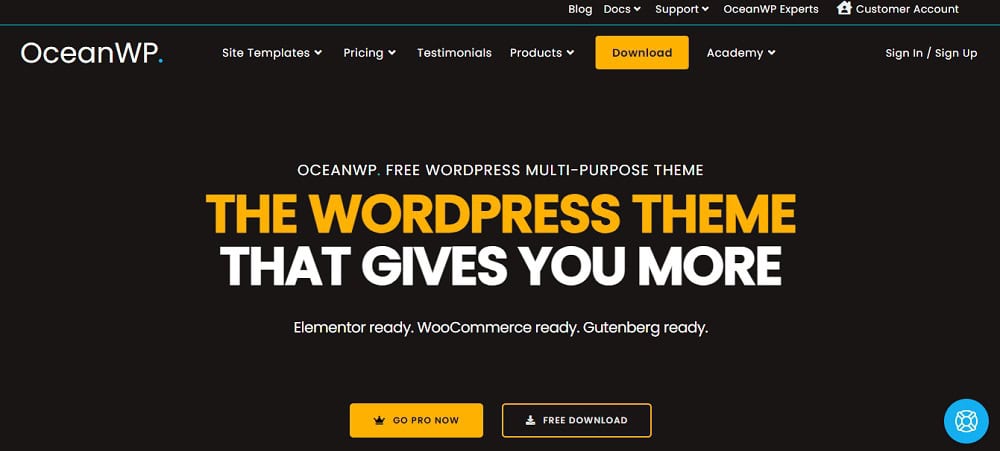
If you are looking for a powerful and flexible alternative to the Astra Theme, the OceanWP Theme is the perfect solution. It is a lightweight and highly customizable WordPress theme that offers a wide range of features and functionalities to help you easily create stunning websites.
OceanWP Theme Key Features
Here are some of the features of OceanWP Theme that make it stand out from other WordPress themes:
- Multiple Demos: OceanWP Theme has over 130 pre-built demos you can import with just one click. These demos cover many niches, including business, portfolio, eCommerce, and more.
- Fast Loading: OceanWP Theme is optimized for speed and performance, ensuring your website loads quickly and smoothly.
- WooCommerce Ready: It is fully compatible with WooCommerce and has many eCommerce-specific features.
- SEO Friendly: OceanWP Theme is designed with SEO in mind, ensuring your website ranks well in search engine results pages.
- Translation Ready: If you want to create a multilingual website, OceanWP Theme is your solution. It is fully compatible with translation plugins like WPML and Polylang.
- Elementor Integration: OceanWP Theme is fully compatible with the Elementor page builder, allowing you to quickly create custom layouts and designs.
OceanWP Theme Pros and Cons
Here are some of the pros and cons of using OceanWP Theme:
Pros:
- Lightweight and fast-loading
- Highly customizable with a wide range of options
- It comes with over 130 pre-built demos.
- Fully compatible with WooCommerce and other popular plugins
- SEO-friendly design
- Translation ready
Cons:
- Some features are only available in the paid version
- Some users may find the interface a bit overwhelming
OceanWP Pricing
OceanWP offers both a free and a paid version of the theme. The free version has basic features and limited support, while the paid version unlocks additional features and premium support.
Here’s a breakdown of the pricing for OceanWP:
- Free version: This is free to use
- Starter Plan: This plan costs $35 per year and has a lifetime subscription of $141. It can be used for one website.
- Personal plan: It costs $43 per year to use for three websites. A lifetime subscription is available for a one-time payment of $178.
- Business plan costs $71 per year for up to ten websites. A lifetime subscription is available for a one-time payment of $285.
- Agency plan: This plan costs $127 per year and can be used on up to 300 websites. A lifetime subscription is also available for a one-time payment of $509.
4. Divi Theme
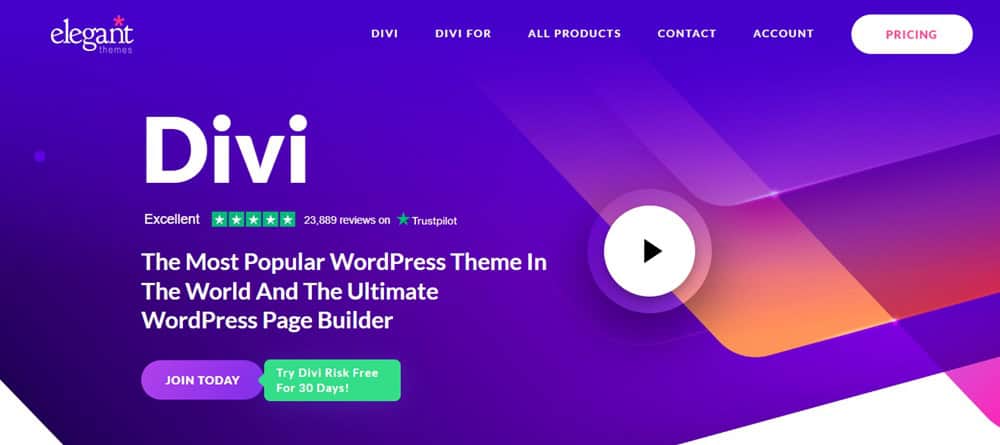
Divi Theme is a popular option if you’re looking for an Astra Theme competitor. It is a multipurpose WordPress theme with a powerful page builder that makes it easy to create custom designs without any coding knowledge.
Divi Theme Key Features
- Visual Page Builder: Divi’s drag-and-drop page builder is one of its most popular features. It allows users to create custom layouts and design elements without coding knowledge.
- Responsive Design: Divi works on all devices, so your website will look great on desktops, tablets, and smartphones.
- Customization Options: With Divi, you can customize your website’s colors, fonts, and layout. You can also use pre-made templates to get started.
- Marketing Integrations: Divi integrates with popular marketing tools like Mailchimp, Aweber, and Google Analytics.
- WooCommerce Support: Divi has built-in support for WooCommerce if you’re selling products online.
- Support and Updates: Divi comes with a lifetime license, which means you’ll get access to updates and support if you use the theme.
Divi Theme Pros and Cons
Here are the pros and cons of Divi Theme:
Pros:
- Divi’s drag-and-drop interface makes it easy to create custom designs without coding knowledge.
- Divi offers a wide range of customization options to create a unique website.
- Divi integrates with popular marketing tools to quickly add email opt-ins and track your website’s performance.
- Divi has built-in support for WooCommerce, making it easy to sell products online.
Cons:
- While Divi is easy to use, learning its features takes time.
- Some users have reported that Divi’s code can be bloated, slowing website performance.
- While Divi offers a wide range of customization options, some users may find the design options limited compared to other themes.
Divi Pricing
Divi is a premium WordPress theme, so you must pay for it. Here are the pricing options for Divi:
- Divi: This costs $89 per year and has a lifetime subscription of $249. It includes access to all of Elegant Themes’ themes and plugins, updates, and support.
- Divi Pro: This plan costs $277 yearly and has a lifetime subscription of $297. It includes access to everything in the Divi plan plus Divi AI, Divi Cloud, and Divi Teams.
5. Blocksy
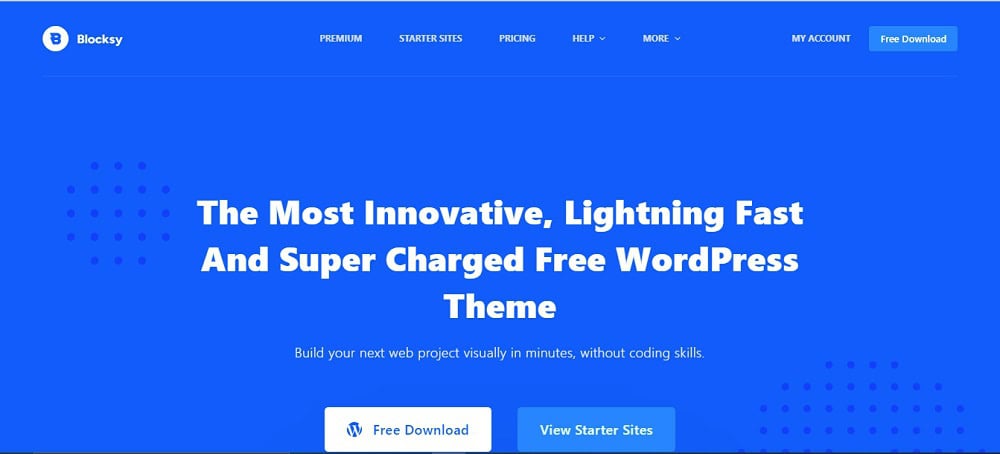
If you are looking for a substitute for the Astra Theme, Blocksy is an excellent option. It is a lightweight and fast WordPress theme that offers a range of customization options, making it a popular choice for beginners and advanced users.
Blocksy Key Features
- Fast Loading: Blocksy is optimized for speed, so your website will load quickly and provide a better user experience.
- Customizable Header and Footer: Blocksy offers a range of customization options for your header and footer, allowing you to create a unique look for your website.
- WooCommerce Integration: Blocksy seamlessly integrates with WooCommerce, making it an excellent choice for creating an online store.
- Gutenberg Compatible: Blocksy is fully compatible with the Gutenberg editor, making creating custom layouts and designs accessible.
- Responsive Design: Blocksy is designed to be fully responsive, ensuring your website looks great on all devices.
- SEO Friendly: Blocksy is optimized for search engines, helping your website rank higher in search results.
Blocksy Pros and Cons
Here are the pros and cons of using Blocksy:
Pros:
- Easy to use and customize
- Fast loading speed
- WooCommerce integration
- Responsive design
- SEO friendly
Cons:
- Limited free version features
- No pre-built templates
- No drag-and-drop page builder
- Limited third-party plugin integration
Blocksy Pricing
Blocksy offers both a free version and a premium version of the theme. Here’s a breakdown of the pricing:
- Blocksy Free: The free version of Blocksy includes basic features and customization options. It’s a good choice for users who are just starting and don’t need advanced functionality.
- Blocksy Premium: Blocksy Premium is available in three pricing tiers:
- Personal: This plan is priced at $69 per year and includes a lifetime subscription of $199. It provides access to all premium features on one website.
- Professional: Priced at $99/year and a lifetime subscription of $299. This plan is ideal for online businesses and can be used on ten websites.
- Agency: Priced at $149 per year and a lifetime subscription of $499. The Agency plan includes access to all premium features for unlimited websites, making it a cost-effective choice for developers and agencies.
6. Neve Theme
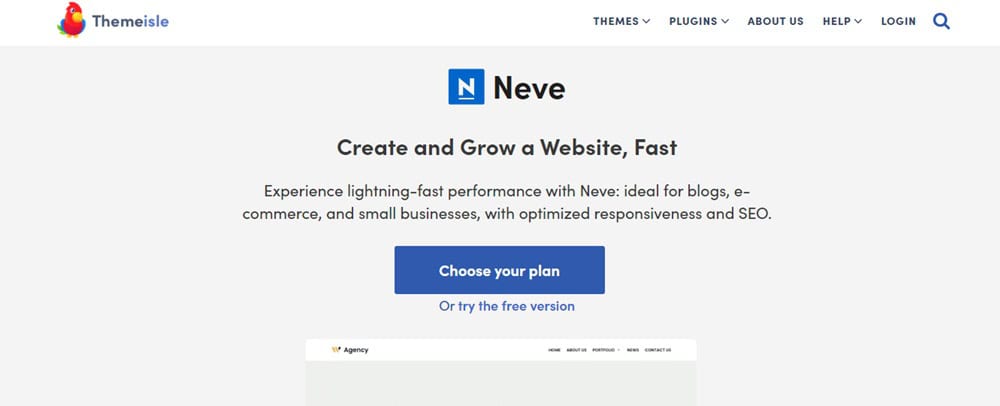
If you are looking for a lightweight, fast, and easily customizable theme, Neve Theme is a great option. It was developed by Themeisle, a popular WordPress theme and plugin development company. Neve Theme is known for its simplicity, speed, and flexibility.
Neve Theme Key Features
- Lightweight and Fast-Loading Design: Neve is designed to be lightweight, ensuring quick load times and efficient performance, which improves user experience and can boost SEO.
- Fully Customizable with a Drag-and-Drop Page Builder: Neve is compatible with popular page builders like Elementor, Beaver Builder, and Gutenberg, allowing you to easily customize your site’s layout and design using drag-and-drop functionality.
- Optimized for SEO and Mobile Devices: The theme follows best SEO practices, helping your site rank better in search engine results. Neve is fully responsive, ensuring your site looks great and functions well on all devices.
- Compatible with Popular WordPress Plugins: Neve works seamlessly with a wide range of popular WordPress plugins, such as WooCommerce, Yoast SEO, and Contact Form 7, allowing you to extend your site’s functionality easily.
- Ready-to-Import Starter Sites for Various Niches: This lets you quickly set up a professional-looking website by importing a pre-built template and customizing it to fit your needs.
- Built-in WooCommerce Integration: Neve includes built-in support for WooCommerce, making it easy to create and customize an online store with features like product pages, shopping carts, and checkout pages seamlessly integrated into your site’s design.
Neve Theme Pros and Cons
Pros:
- Lightweight and fast
- Easy to customize
- Compatible with popular page builders
- SEO optimized
- WooCommerce ready
Cons:
- Limited free version features
- Some features require paid add-ons
- Limited design options
Neve Theme Pricing
- Free: This is free to use.
- Personal: This costs $69/year. This plan is great for users just getting started with their websites.
- Business: This plan costs $149/year and is best for online shops.
- Agency: This plan is excellent for freelancers and agencies, costing $259/per year.
7. Elementor Hello Theme

The Elementor Hello Theme is a great substitute for the Astra Theme. It is an excellent choice if you are looking for a lightweight, fast, and highly customizable theme that works seamlessly with the Elementor page builder.
Elementor Hello Theme Key Features
- Drag and Drop Page Builder: This allows you to create and customize website pages by simply dragging and dropping elements into place, providing a highly intuitive design experience without needing coding knowledge.
- Customizable Templates and Widgets: These pre-designed elements can be easily tailored to fit your website’s specific needs, making it quick and easy to build professional-looking pages.
- Mobile Responsive Design: This means your site will look great and function well on desktops, tablets, and smartphones, providing an optimal user experience across all platforms.
- WooCommerce Compatibility: The Hello Theme is fully compatible with WooCommerce. You can use Elementor’s design capabilities to build product pages, shopping carts, and checkout pages, ensuring a cohesive and visually appealing e-commerce site.
- SEO Optimization: The Hello Theme is lightweight and optimized for speed, which is crucial for SEO. Faster load times improve user experience and can lead to better search engine rankings. Additionally, the theme works well with popular SEO plugins like Yoast SEO, enabling further optimization of your site’s content and structure.
- Multi-language Support: It is compatible with translation plugins like WPML and Polylang, allowing you to offer your content in multiple languages and reach a wider audience.
Elementor Hello Theme Pros and Cons
Here are the pros and cons of using the Elementor Hello Theme:
Pros:
- Easy to use
- Flexible and customizable
- Mobile responsive design
- WooCommerce compatibility
- Free to use
Cons:
- Some features require additional plugins
- It can be slow on some hosting providers
Elementor Hello Theme Pricing
Elementor Hello Theme is forever free to use.
8. Avada Theme

If you’re looking for a versatile and feature-rich WordPress theme, Avada Theme is a great option. It has been around since 2012 and is continuously updated to keep up with the latest design trends and technology.
Avada Theme Key Features
- Easy-to-use: A drag-and-drop page builder that makes it easy to create custom layouts
- Pre-built Templates: There are over 70 pre-built website designs to choose from
- Compatibility: Compatibility with popular WordPress plugins like WooCommerce and Gravity Forms
- Responsive Design: A responsive design that looks great on all devices
- Highly Customizable: Customizable headers and footers
- SEO Options: Avada has built-in SEO optimization tools to ensure your pages are search engine optimized.
Avada Theme Pros and Cons
Like any WordPress theme, Avada Theme has its pros and cons. Here are some of the advantages and disadvantages of using Avada Theme:
Pros:
- A wide range of features and customization options
- A powerful page builder that makes it easy to create custom layouts
- Built-in support for WooCommerce and other popular plugins
- Regularly updated to keep up with the latest WordPress trends and technology
- Excellent documentation and support
Cons:
- It can be overwhelming for beginners due to the wide range of options and features.
- The page builder can be slow to load on some sites
- Some users have reported issues with compatibility with specific plugins.
Avada Pricing
Avada is a premium WordPress theme, which means it has a price tag. A regular license costs $69, which includes lifetime updates and six months of support. You can purchase an extended support package for an additional fee if you need more support.
9. Genesis Framework

Genesis Framework is a popular WordPress theme framework that offers a wide range of features and customization options. It is a great alternative to the Astra theme.
Genesis Framework Key Features
- SEO optimized: Genesis Framework is designed with SEO in mind, making optimizing your website for search engines easy.
- Mobile responsive: The theme is mobile responsive, ensuring your website looks great on all devices.
- Customizable: Genesis Framework offers customization options, including custom widgets, page templates, and theme options.
- Fast loading: The theme is optimized for speed, ensuring your website loads quickly.
- Secure: Genesis Framework is built with security in mind, making it a safe and secure option for your website.
- Developer-friendly: The theme is designed to be developer-friendly, with a wide range of hooks and filters for customization.
Genesis Framework Pros and Cons
Pros:
- Wide range of customization options
- SEO optimized
- Mobile responsive
- Fast loading
- Secure
- Developer-friendly
Cons:
- Limited free child themes
- The steep learning curve for beginners
Genesis Framework Pricing
Genesis Framework is free when you host on WP Engine or Flywheel. You can subscribe to Genesis Pro for more advanced features, which costs $360 yearly.
Why Should You Consider an Alternative to Astra Theme?
Astra is a popular theme that offers various customization options and is known for its speed and performance.
While the Astra theme is highly regarded for its flexibility, speed, and extensive customization options, it does have some limitations.
Firstly, Astra’s advanced features and customization options are only available through the Astra Pro plugin or additional add-ons. While Astra is compatible with many popular plugins, achieving certain functionalities may require third-party plugins.
Although Astra offers customization options for headers and footers, it lacks the advanced drag-and-drop builder in themes like Kadence WP. Users looking for highly intricate header and footer designs might find Astra’s capabilities somewhat restrictive.
While extensive, Astra’s pre-built templates and design options can sometimes feel limiting if you want to create a unique or unconventional website design.
Although Astra is user-friendly, beginners might find the extensive customization options overwhelming.
Some users might find that feature updates and new additions are slower than those of other rapidly evolving themes. While Astra is regularly updated for compatibility and security, significant new features might not be introduced as frequently.
Another limitation of Astra is that it might not suit everyone’s needs. Astra is a lightweight theme designed to work well with page builders like Elementor and Beaver Builder. If you are not using a page builder, you might not be able to take advantage of Astra’s features.
Choosing the Right Platform
Several factors must be considered when choosing the right platform for your website.
Here are some key considerations to keep in mind:
1. Your Website Goals
Before you choose a platform, it’s crucial to determine your website goals. Are you looking to create a blog, an online store, a portfolio, or a corporate website?
Different platforms offer different features and functionality, so choosing a platform that aligns with your goals is essential.
2. Ease of Use
Another essential factor to consider is ease of use. If you’re new to website building, you’ll want a platform that is easy to navigate and use. Look for platforms with intuitive interfaces and drag-and-drop functionality.
3. Customization Options
Customization options are also important. You’ll want a platform to customize your website to suit your brand and aesthetic. Look for platforms with various themes and templates and customization options for fonts, colors, and layouts.
4. SEO Friendliness
Search engine optimization (SEO) is crucial for driving traffic to your website. Look for SEO-friendly platforms with features such as customizable meta tags, clean code, and fast load times.
5. Support and Community
Finally, consider the support and community offered by the platform. Look for platforms with active communities, support forums, and responsive customer support. This can be especially important if you run into technical issues or have questions about using the platform.
Final Thoughts on Astra Theme Alternatives
While the Astra theme remains popular for many WordPress users, exploring its alternatives can provide unique advantages depending on your specific requirements.
Kadence WP is the best alternative due to its advanced header and footer builder, dynamic content options, and built-in performance enhancements. It is an excellent choice for those seeking flexibility and speed.
Developed by Elegant Themes, Divi Theme is a highly versatile and popular WordPress theme that caters to a wide range of website needs. Known for its powerful drag-and-drop page builder and extensive customization options, Divi makes it easy for users of all skill levels to create stunning and functional websites without needing any coding knowledge.
Finally, the Elementor Hello Theme offers a minimalist, blank canvas that pairs perfectly with the Elementor page builder, giving users unparalleled design freedom and performance optimization.
By considering these alternatives, you can find a theme that aligns with your vision and enhances your WordPress experience, ensuring you build a website that meets your goals efficiently and effectively.
Frequently Asked Questions on Astra Theme Alternatives
What are some free alternatives to the Astra WordPress theme?
Some popular free themes are Kadence WP, Elementor Hello Theme, GeneratePress, and OceanWP. These themes offer a range of features and customization options that can help you create a professional-looking website without spending a dime.
Which WordPress themes are considered the best competitors to Astra?
These themes include the Kadence WP Theme, Elementor Hello Theme, GeneratePress, and OceanWP. These themes offer similar features and customization options and are known for their high performance and ease of use.
How does the Kadence WP theme compare to Astra in terms of features and performance?
Both Kadence WP and Astra excel in features and performance, making them top choices for WordPress users. But Kadence WP stands out with its advanced header and footer builder, dynamic content options, and built-in performance enhancements.
Can GeneratePress be a suitable replacement for the Astra theme for professional websites?
GeneratePress is a lightweight WordPress theme often considered a suitable replacement for the Astra theme. It offers a range of customization options and is known for its fast loading times and optimized code. It also has a built-in page builder and supports WooCommerce integration, making it an excellent choice for professional websites.
In terms of customization and ease of use, how does the Neve theme stand up against Astra?
Neve is a lightweight WordPress theme known for its ease of use. It has a built-in page builder and supports WooCommerce integration. It also has a range of pre-built demos and templates to help you get started quickly. Regarding customization, Neve offers a range of easy-to-use options, making it an excellent option for beginners.
Disclosure: We may earn commissions if you buy via links on our website. Commissions don’t affect our opinions or evaluations. We’re also an independent affiliate of many platforms, including ClickFunnels, Kartra, GoHighLevel, Podia, Northwest Registered Agent, and others. We’re not employees of these services. We receive referral payments from them, and the opinions expressed here are our own and are not official statements of these companies.


















